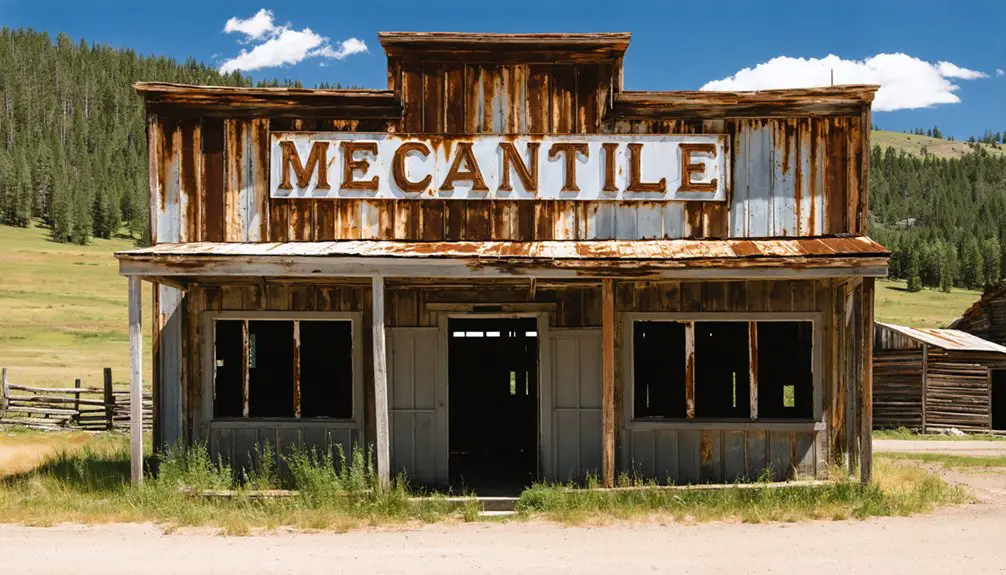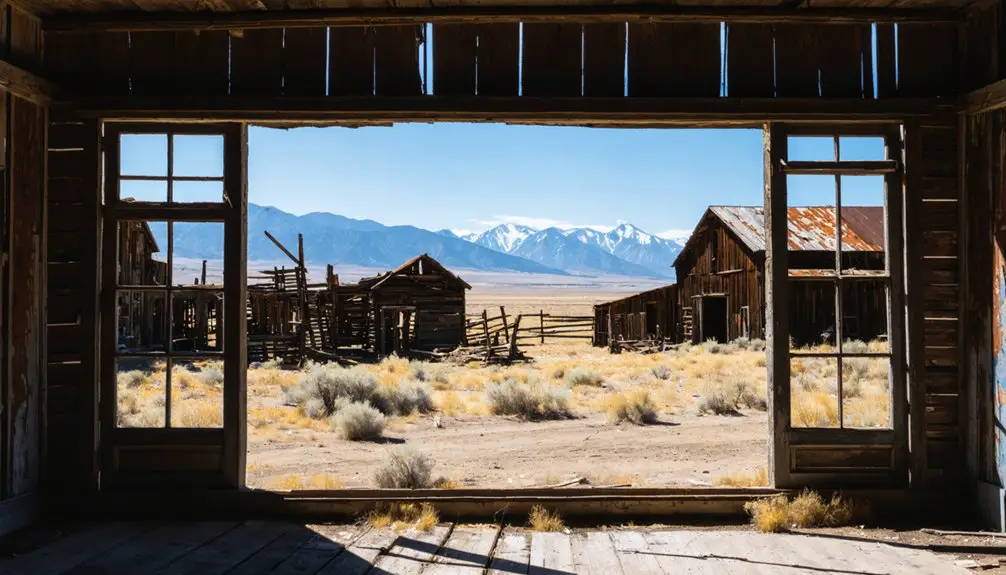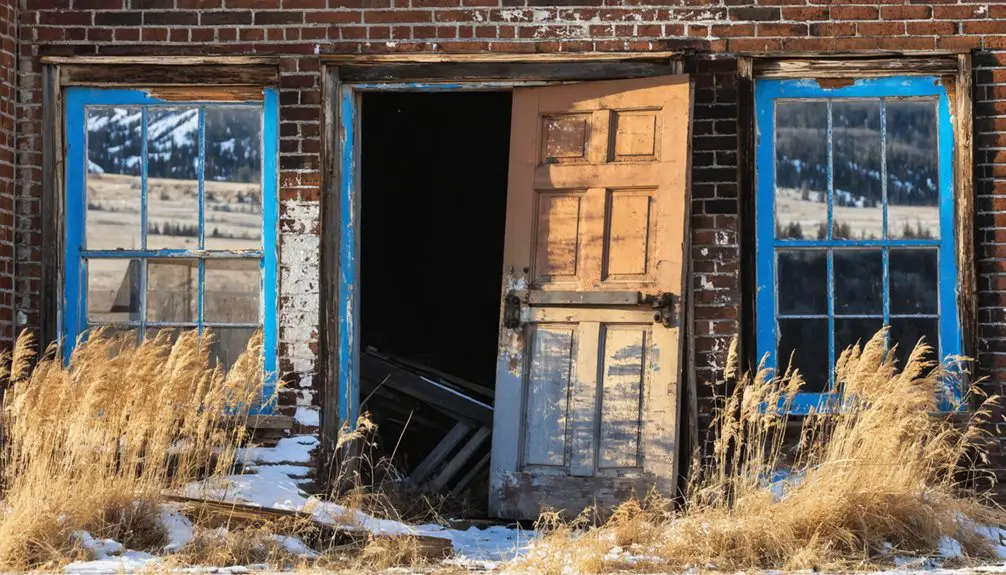You’ll find Bear Creek tucked away in Montana’s coal country, where a once-bustling mining town of 3,000 residents now stands silent. Founded in 1905, it flourished after the railroad’s arrival, attracting European immigrants who built a vibrant community around seven mercantile stores and productive coal mines. The devastating Smith Mine disaster of 1943 and declining coal industry led to its abandonment, though its weathered structures and cemetery still whisper tales of ambition, tragedy, and frontier resilience.
Key Takeaways
- Bear Creek, Montana began as a thriving coal mining town in 1905, reaching a peak population of 3,000 during its most prosperous years.
- The devastating Smith Mine disaster of 1943 killed 74 miners and marked the beginning of the town’s decline.
- Economic challenges, including the closure of Bearcreek Bank in 1928 and diminishing coal profitability, led to the town’s abandonment.
- Today, weathered structures, mining equipment remnants, and the historic Bearcreek Bank building stand as witnesses to the ghost town’s past.
- Visitors can explore the town’s mining heritage through the Carbon County Historical Society & Museum and Bear Creek Saloon.
The Birth of a Mining Town (1905)
In 1905, two ambitious entrepreneurs, George Lamport and Robert Leavens, established the town of Bearcreek in Montana’s coal-rich Bear Creek district. Under their town leadership, Bearcreek quickly transformed from untamed wilderness into a bustling mining community, drawing immigrants from across Europe who brought their rich traditions with them.
You’ll find the town’s early success was largely due to the Montana, Wyoming and Southern Railroad‘s construction in 1906, connecting Bearcreek’s coal mines to the Northern Pacific mainline at Bridger. Backed by Billings businessman Phil Gallaher and Pennsylvania investors, the railroad enabled the mines to flourish. The population grew steadily and reached its peak of over 300 residents during World War II.
The town soon boasted seven mercantile stores, making it a significant commercial hub for the region’s miners and their families.
Coal Discovery and Early Development
While ancient geological processes formed Bear Creek’s valuable coal deposits over millions of years, James “Yankee Jim” George first discovered the area’s coal potential in 1866.
You’ll find that early mining techniques were basic, with small-scale operators extracting coal primarily for local domestic heating. The superior quality sub-bituminous coal lay within the Fort Union Formation, created from prehistoric subtropical coastal plains and transformed by tectonic forces.
Despite the coal’s high grade, development remained limited until transportation improved. Early miners faced rugged terrain and primitive extraction methods, which minimized their environmental impact compared to later operations. The Crow Indian land restrictions significantly delayed initial coal development in the region.
Basic mining tools and challenging landscapes kept early coal extraction modest, naturally constraining environmental damage in Bear Creek’s initial operations.
The Washoe Coal Company’s attempt at commercial mining in 1892 failed due to transport costs, but Lamport and Smith’s 1897 venture proved more successful, setting the stage for Bear Creek’s mining boom.
Railroad’s Arrival and Economic Growth
The Montana, Wyoming and Southern Railroad‘s arrival in 1906 connected Bearcreek’s coal mines to the Northern Pacific mainline at Bridger, transforming the town’s economic prospects.
You’ll find that this privately owned rail spur enabled efficient coal transport to broader markets, which directly fueled the rapid growth of mining operations to employ 1,200 miners by 1917.
The railroad’s presence attracted waves of immigrant workers, primarily Serbian, Montenegrin, Scottish, German, and Italian miners, who helped expand Bearcreek’s population to nearly 3,000 residents and established a culturally diverse mining community with thriving businesses and social venues. Due to high demand for coal during this period, the area supported seven major mines operating simultaneously. The Great Northern Railway, formed in 1889, helped establish additional transportation routes in the region, further boosting coal distribution capabilities.
Railroad Construction Timeline
Rail transportation transformed Bear Creek’s economic landscape when the first tracks entered Montana Territory on May 9, 1880, crossing Monida Pass during its northward expansion.
The Utah and Northern Railway reached Butte by December 1881, while the Northern Pacific Railroad pushed through key locations like Glendive and Livingston in the following years. Montana Central Railway completed a crucial branch line connecting Butte, Anaconda, and Garrison in 1883.
You’ll find that railroad expansion accelerated dramatically with the founding of the Butte, Anaconda and Pacific Railway in 1892.
This transportation evolution brought essential connections to the copper mining industry, with the first freight service beginning in December 1893, followed quickly by passenger trains.
While some ambitious plans, like extending the line to the Bitterroot Valley, never materialized, the BA&P’s construction marked an important turning point in Bear Creek’s development and its connection to Montana’s broader rail network. The BA&P made history when it introduced electric locomotives in 1913, significantly reducing operating costs for the region’s mining operations.
Economic Impact on Mining
Mining operations in Bear Creek remained economically stagnant until 1906, when the arrival of the Yellowstone Park Railroad transformed the region’s prospects.
Before rail access, you’d find mining technology limited by costly wagon transport over challenging terrain. The Montana Coal & Iron Company seized this revolutionary moment, developing the Smith Mine into a profitable venture that would shape the area’s destiny.
The railroad’s impact created four key economic shifts:
- Transportation costs plummeted, making commercial mining viable
- Market access expanded through efficient boxcar shipping
- Mining technology advanced with increased capital investment
- Labor movements gained strength as operations scaled up
You’ll find Bear Creek’s story reflects the broader pattern of western mining towns, where railroad connections often meant the difference between boom and bust in America’s resource-rich frontier.
Community Growth and Development
Following the arrival of the Yellowstone Park Railroad in 1905, Bear Creek transformed from a scattered mining settlement into a bustling frontier town.
Within a decade, you’d have found a thriving community of nearly 2,000 residents, showcasing remarkable community resilience as immigrants from Serbia, Scotland, Montenegro, Germany, and Italy worked side by side in the mines.
The town’s rapid growth brought sophisticated amenities unusual for Montana mining communities – concrete sidewalks, an extensive water system, and buildings crafted from local sandstone.
You’d have seen a Romanesque Revival bank, multiple mercantiles, two hotels, and several saloons. To avoid confusion with other Bear Creek locations, historical records often refer to this site as Bear Creek, Montana.
While labor relations centered around the mines that employed 1,200 workers by 1917, the railroad’s presence guaranteed Bear Creek’s position as a crucial regional coal shipping hub.
Peak Years and Cultural Diversity

During its peak years around World War I, you’d find over 2,000 residents calling Bearcreek home, creating a vibrant tapestry of Serbian, Scottish, Montenegrin, German, and Italian cultures.
You’d hear multiple languages echoing through the streets as immigrant miners and their families gathered at the town’s numerous saloons and billiard halls, which served as cultural hubs in the absence of any formal church.
Despite their diverse backgrounds, these hardworking miners forged a unified community bound together by their shared coal mining heritage and daily life in this bustling Montana town. Life in Bearcreek revolved around the Smith Mine Historic District, where most residents earned their livelihood.
Like many other mining boom towns, Bearcreek’s population fluctuated dramatically with the success and decline of its mining operations.
Thriving Mining Community Life
As World War I fueled America’s hunger for coal, the remote mountain town of Bearcreek swelled to nearly 2,000 residents, transforming into a bustling hub of commerce and industry.
You’d find a vibrant community where miners from diverse backgrounds – Serbians, Scotsmen, Montenegrins, Germans, and Italians – gathered after their shifts.
The town’s social fabric was woven through:
- Seven well-stocked mercantiles serving daily needs
- Local saloons hosting community gatherings and miner traditions
- Two billiard halls providing entertainment and social connection
- The Lampert Hotel offering “well-furnished” rooms for visitors
While Bearcreek never built a church, the town’s concrete sidewalks, extensive water system, and locally quarried sandstone buildings reflected its prosperity.
The Montana Wyoming and Southern Railway connected this thriving community to larger markets, ensuring its place in Montana’s coal industry.
Cultural Traditions Unite Workers
While many mining towns were culturally homogeneous, Bearcreek stood out for its remarkable ethnic diversity and rich cultural tapestry. You’d find Serbs, Montenegrins, Scots, Germans, and Italians working side by side in the mines, bringing their immigrant traditions to this Montana town.
After the railroad’s arrival in 1906, the population swelled to 3,000, creating a vibrant multicultural community.
The town’s cultural celebrations reflected this unique blend, most significantly in its twice-celebrated Christmas – once on December 25 and again on January 6 for Serbian Orthodox observers.
Though Bearcreek lacked a formal church, cultural and religious practices thrived through informal gatherings. Local establishments like the Bearcreek Saloon became essential social hubs where miners of all backgrounds gathered, fostering unity through shared experiences and traditions.
Life in the Mining Community
Once coal mining operations began in Bear Creek during the 1890s, the town quickly transformed into a bustling hub of activity that would support over 3,000 residents at its peak.
The community dynamics reflected a rich tapestry of American-born and immigrant workers who’d established daily routines centered around the demanding coal industry.
Immigrant and American miners forged a vibrant community spirit through their shared experiences in Bear Creek’s coal-driven daily life.
You’d find life in Bear Creek revolved around these essential elements:
- Mining work that required significant skill and courage, with men laboring in dangerous underground conditions
- A network of small communities nestled in steep coulees close to the mines
- The critical Montana, Wyoming & Southern Railway that connected the town to larger markets
- Social gatherings at places like the Bearcreek Saloon, where events like pig races brought the community together
The Tragic Smith Mine Disaster
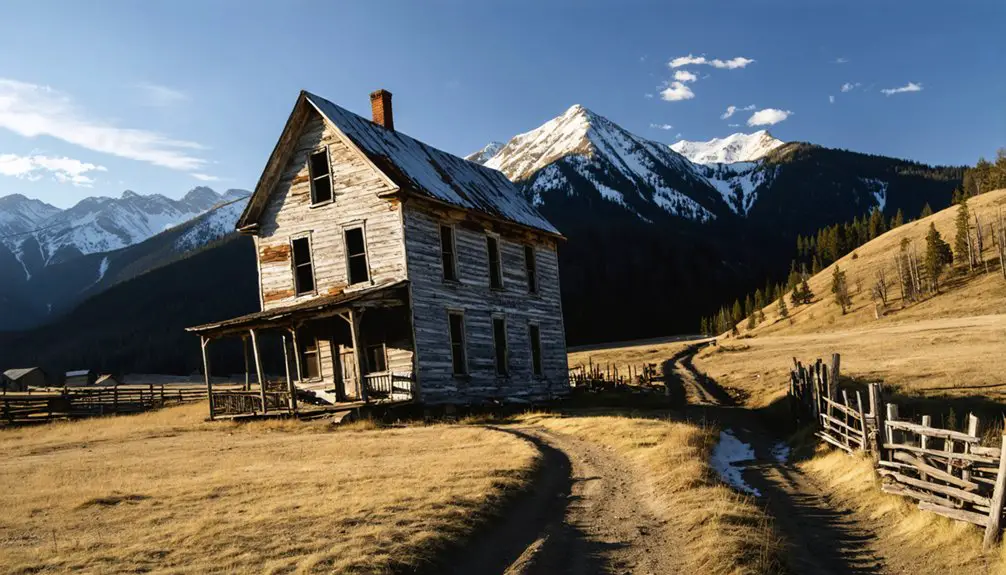
Though Bear Creek had weathered many challenges since its founding, nothing could have prepared the community for the devastating Smith Mine disaster of February 27, 1943.
When methane gas and coal dust ignited deep within Mine No. 3, the explosion claimed 74 miners’ lives, leaving 58 widows and 125 fatherless children in its wake. Only three miners survived.
The disaster response revealed the mine’s inadequate safety measures – from poor ventilation to insufficient rescue equipment.
You’ll find the tragedy’s toll etched deeply in Bear Creek’s story: one woman lost 11 relatives, while six of eight high school seniors lost their fathers.
The community’s resilience was tested as families waited desperately for news at mine headquarters, but the catastrophe ultimately led to Bear Creek’s decline, transforming a once-thriving town into a shadow of its former self.
Economic Downturn and Abandonment
Before the devastating Smith Mine disaster, Bear Creek’s fortunes had already begun to waver with the closure of the Bearcreek Bank in 1928. The town’s economic dependency on coal mining made it vulnerable to market shifts and operational challenges.
You can trace Bear Creek’s decline through these key developments:
- Coal mining profitability plummeted as seams exhausted and competition from other energy sources increased.
- Transportation costs soared when rail service diminished, making operations more expensive.
- Businesses and social institutions shuttered as miners and their families left town.
- Infrastructure deteriorated as the population dwindled, further weakening community resilience.
Without economic diversification beyond mining, Bear Creek couldn’t weather these changes. The once-thriving hub of 3,000 residents saw its commercial significance fade as workers sought opportunities elsewhere.
Modern Day Ghost Town Remnants
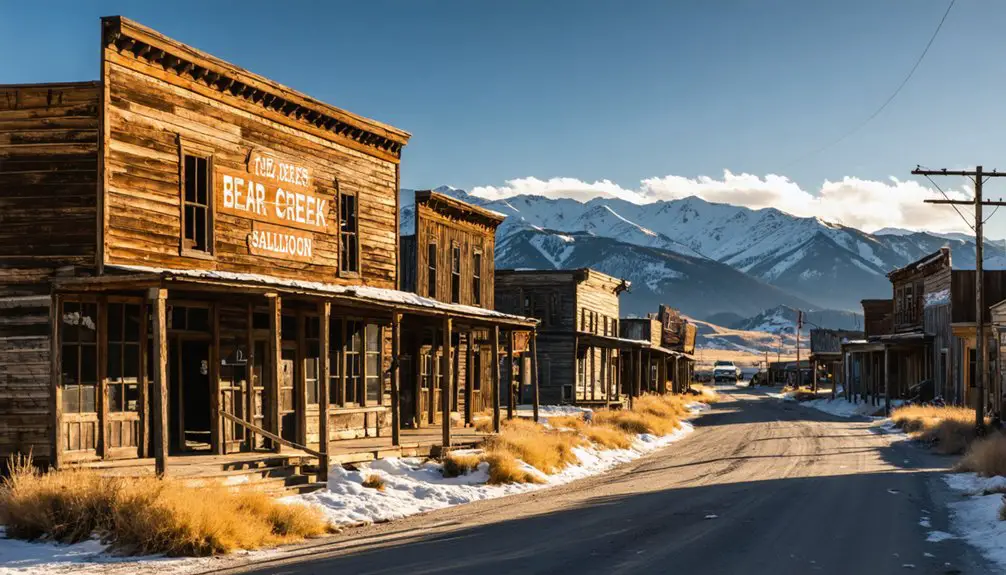
When you visit Bear Creek Ghost Town today, you’ll find a haunting collection of weathered structures along the main street, with most original buildings having been demolished or relocated over time.
The Smith Mine Historic District contains the most significant remaining structures, including rusting mining buildings that stand sentinel beside a memorial stone commemorating the 74 miners lost in the 1943 disaster.
While the rail tracks that once connected this bustling coal town to wider markets were removed in 1953, you can still examine scattered remnants of mining equipment and derelict buildings that offer glimpses into Bear Creek’s industrial past.
Standing Structures Today
The rugged silhouettes of Bear Creek’s original buildings stand as silent sentinels to the town’s mining legacy.
You’ll find weathered remnants of community structures scattered across the landscape, from residential cabins to the skeletal framework of what was once a bustling saloon.
Despite minimal historic preservation efforts, you can still explore:
- Wood-frame buildings with their authentic weathered exteriors and broken windows
- Former gathering places including community halls and store foundations
- Visible roadways and trails that once connected Bear Creek to neighboring mining camps
- Support structures like stamp mill foundations and ore storage facilities
These standing structures tell the tale of Bear Creek’s vibrant past, offering you a glimpse into the daily lives of the hardy souls who once called this mining town home.
Mining Equipment Remains
Among the most compelling remnants at Bear Creek’s ghost town site, you’ll find scattered pieces of mining equipment that paint a vivid picture of its coal mining past.
You can spot rusting ore carts, rails, and fragments of ventilation systems that once supported mining operations reaching depths of 7,000 to 8,000 feet at Smith Mine #3. While most entrance shafts have collapsed, you’ll discover remnants of conveyor belts, metal hoists, and processing equipment near the old surface buildings.
The devastating 1943 mine disaster left much of the underground mining machinery buried or destroyed.
Today, the rusted frames and structural beams serve as silent witnesses to both the town’s industrial heritage and tragic end, though minimal equipment preservation efforts mean these artifacts continue to decay with time.
Legacy and Historical Significance
As a proof of Montana’s mining heritage, Bear Creek’s enduring legacy stems from its dramatic rise and fall during the early 20th century coal mining era.
You’ll find this once-thriving community’s story deeply woven into the fabric of Western mining history, particularly through its cultural preservation efforts.
The town’s historical significance is marked by:
- The iconic Bearcreek Bank building, showcasing Romanesque Revival architecture in native sandstone
- The tragic 1943 Smith Mine disaster that claimed 74 lives and led to improved mining safety regulations
- The cemetery that serves as a solemn reminder of the community’s sacrifices and resilience
- The architectural remnants that highlight the essential role of mining commerce in Montana’s early development
Today, these preserved elements tell a powerful story of ambition, tragedy, and the untamed spirit of frontier mining communities.
Unique Cultural Attractions Today
Modern visitors to Bear Creek can explore a rich tapestry of cultural attractions that bridge the past and present.
You’ll find the lively Bear Creek Saloon & Steakhouse at the heart of local cuisine and entertainment, where you can experience the unique Bear Creek Downs Pig Races – the only legal pig-racing betting venue in Montana.
The Carbon County Historical Society & Museum in nearby Red Lodge brings mining history to life through immersive exhibits and artifacts.
Step back in time at the Carbon County Historical Society & Museum, where Montana’s rich mining heritage comes alive.
While exploring the town, you’ll discover historic markers that tell compelling stories, including the prominent Bearcreek Bank building with its distinctive Romanesque Revival architecture.
These cultural festivals and attractions weave together the area’s mining heritage with contemporary small-town charm, creating an authentic Montana experience you won’t find anywhere else.
Frequently Asked Questions
Are There Any Reported Ghost Sightings or Paranormal Activity in Bearcreek?
While local legends mention ghostly encounters near the Smith Mine disaster site where 75 people died, you won’t find documented paranormal activity within Bearcreek town itself, despite the region’s haunted reputation.
What Happened to the Mining Equipment After the Mines Closed?
Like sleeping giants frozen in time, you’ll find abandoned mining equipment scattered across Bear Creek’s landscape. Most heavy machinery was left behind, while workers salvaged smaller tools they could carry.
Can Visitors Explore the Abandoned Mine Tunnels Today?
You can’t explore the mine tunnels today – they’re sealed off for mine safety and historical preservation. All access is restricted due to dangerous conditions and collapse risks underground.
How Many Original Buildings From the Mining Era Still Stand?
You’ll find just a handful of historically preserved buildings, including the architecturally significant Bearcreek Bank, Jurcak Boarding House, Ellingson Mercantile, a stone residence, and the Bearcreek Saloon still standing from mining days.
Do Any Descendants of the Smith Mine Victims Still Live Nearby?
Ever wonder about those deep family connections? You’ll find descendant stories alive today, as several families of Smith Mine victims maintain roots near Bearcreek, preserving their heritage through local memorials and community gatherings.
References
- https://townofbearcreekmt.com
- https://www.ktvq.com/news/local-news/ghostly-site-smith-mine-a-haunting-legacy-of-a-montana-tragedy
- https://en.wikipedia.org/wiki/Bearcreek
- https://www.ghosttowns.com/states/mt/bearcreek.html
- https://www.hmdb.org/m.asp?m=190160
- https://npgallery.nps.gov/NRHP/GetAsset/621004b7-bde1-4a06-bb98-4646b4b10fb9
- https://sweetheartsofthewest.blogspot.com/2017/11/bearcreek-montana-beginning-and-end.html
- https://montanahistoriclandscape.com/2015/09/30/carbon-countys-bearcreek-and-the-smith-mine-disaster/
- https://data.visitmt.com/data/cities/MT/BEARCREEK
- https://www.mdt.mt.gov/travinfo/docs/roadsigns/BlackGold.pdf
